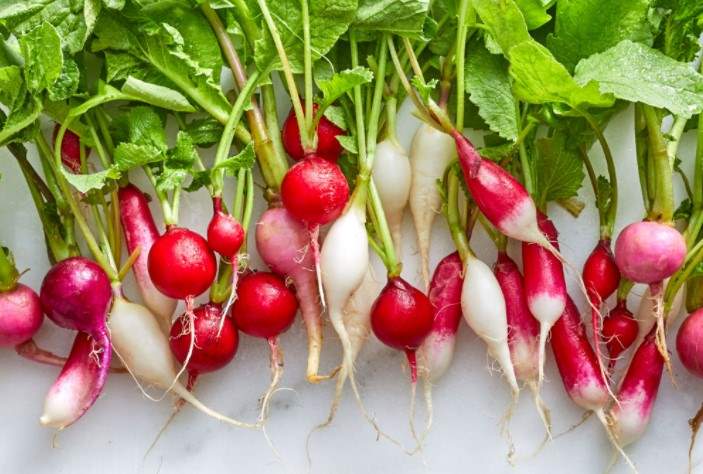If you love radish, whose root, it’s good to known if your rabbits can eat it too, including its tops or greens (leaves and stems).
Radish or Raphanus raphanistrum subsp. sativus is a root vegetable that belongs to the family Brassicaceae, the cabbage, crucifers, or mustards family that has similar plants like parsnips or swede (rutabaga). However, the tops may also be a green leaf. Some people sprout seeds and eat them too.
There are various subspecies, varieties, or cultivars characterized by their color (pink, white, yellow, or grey-black), their size, shape, and lengths as some grow longer than parsnips as well as in their taste and flavor.

However, horseradish (Armoracia rusticana) and Wasabi or Japanese horseradish (Wasabia japonica) are plants in the same family but a different genus.
Can rabbits eat radishes?
Yes. Rabbits can eat radish (the root) as an occasional treat. Like any other non-leafy vegetable, please give them a teaspoon per two pounds of their body weight or 1-2 small slices, once or twice a week. Most bunnies will find the crispy texture sheer thrill and can stand their spicy, peppery flavor.
The other concern is whether radishes are good for bunnies or not. The answer is, yes, they are ok. Besides bring adding texture, variety, and taste, they will promote hydration (have 95% water), are low in carbs (3%), and moderate in vitamin C. They also have small amounts of folate, vitamin B6, potassium, and other nutrients.
A more reason why you need to include this vegetable root in their diet is that it has isothiocyanates that have an anti-cancer effect and well as natural antifungal properties, from the antifungal protein RsAFP2.
However, it is essential to note that radishes are low in fiber, something that is contrary to ideal diets for bunnies, and an excessive amount may cause digestion problems. Fiber helps in promoting food movement in the gut and support a healthy digestive system.
Can rabbits eat radish greens or leaves?
Yes. Rabbits can eat radish greens (leaves and stems too) in moderation as an occasional part of their leafy greens. They are safe (not toxic and poisonous) and even better than the roots.
Radish greens or leaves are rich in vitamins A, B6, and C, magnesium, calcium, iron, folic acid, potassium, magnesium, and antioxidants. Antioxidants will neutralize free radicals that may cause oxidative damage and prevent some chronic diseases.
However, they are high in oxalic acid, liked to oral irritation, and formation of calcium oxalate stones that may end up in their bladder or kidney. Also, a prolonged and excessive amount may cause acute kidney failure.
Furthermore, they are also very high in calcium 400mg per 100g (1), which may result in urinary calcium sludge or bladder sludge due to excessive calcium crystals. How much calcium rabbits absorb is correlated to the amount in their diet. However, they have to excrete the excess amount, leading to the formation of bladder sludge.
Therefore, when feeding radish greens to your rabbits, ensure you follow these two critical rules to avoid the effects of high oxalic and calcium they have:
- Don’t include any other vegetable that is high in oxalic acid like beet greens, Swiss chard, spinach, parsley, or sprouts that are 1-6 days.
- Don’t include any other vegetable high in calcium like collard greens, carrot tops, Chinese greens, spring greens, turnip green, kale dandelion greens, or spring greens.
Instead, go for veggies like arugula, bean plants, broccoli leaves, cabbage, chickweed, clovers, cucumber leaves, lettuce, okra leaves, pea plant, plantain leaves, watercress, among others.
Finally, on amounts, make it part of the 5-6 leafy veggies that your rabbits eat. One packed cup should be enough for your two-pound rabbit.
Give diet in right portions
Besides introducing radish or any other new food gradually to give your rabbit’s gut to adjust to it to avoid stomach upset, ensure it is organic (not treated with harmful fertilizers, pesticides, or herbicides). Also, note that a correct diet is vital in the wellbeing of your rabbit.
For instance, did you know that too much leafy greens, even the healthiest time with an insufficient amount of grassy hay, will result in diarrhea or loose stool as well as other digestive upsets? Therefore, keep any fresh food at 10-15% while hay should be at least 80%.
Similarly, too many pellets and treats will be unhealthy to your bunnies as they may fatten them or even cause stomach upsets. Ensure your rabbits have only 5% of high-fiber pellets and 0-5% treats, which include commercial treats, herbs, flowers, non-leafy veggies, and fruits.
More on radishes
Radish subspecies are green, daikon, black, red, oilseed, and wild radish. Also, there are the European, summer, or spring radishes cultivars like April Cross, Bunny Tail (Italian), Cherry Belle, Champion, Red King, Sicily Giant, Snow Belle, White Icicle, French Breakfast, plum purple, and Easter egg.
On the other hand, the winter varieties include Black Spanish (Black Spanish round or black radish), daikon (winter oilseed radishes from Asia, also known as Japanese, Oriental, or Chinese radish), and Korean radish (white).
